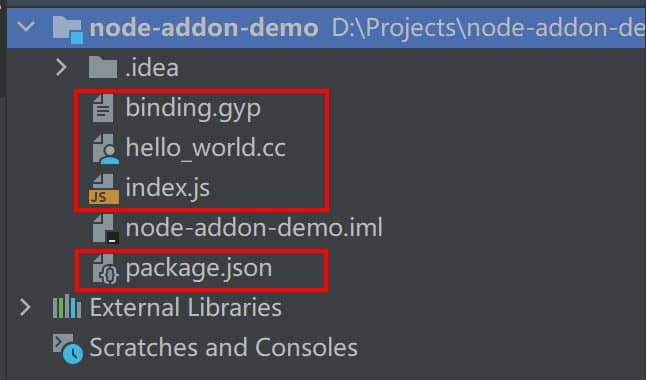通过样例,让我们了解如何编写一个node的原生模块。当然,这篇文章还有一个目的,是为了方便以后编写关于node-gyp的文章,搭建初始环境。
基于node-addon-api
基于node-addon-api的nodejs插件,使用的是node的头文件:#include <node.h>。
hello_world.cc
1
2
3
4
5
6
7
8
9
10
11
12
13
| #include <node.h>
void Method(const v8::FunctionCallbackInfo<v8::Value>& args) {
v8::Isolate* isolate = args.GetIsolate();
args.GetReturnValue().Set(v8::String::NewFromUtf8(
isolate, "world").ToLocalChecked());
}
void Initialize(v8::Local<v8::Object> exports) {
NODE_SET_METHOD(exports, "hello", Method);
}
NODE_MODULE(NODE_GYP_MODULE_NAME, Initialize)
|
binding.gyp
1
2
3
4
5
6
7
8
| {
"targets": [
{
"target_name": "hello_world",
"sources": [ "hello_world.cc" ]
}
]
}
|
index.js
1
2
3
| const binding = require('./build/Release/hello_world');
console.log(binding.hello());
|
package.json
1
2
3
4
5
6
| ...
"scripts": {
"build": "node-gyp configure && node-gyp build",
"run:demo": "node index.js"
},
...
|
整体结构

按照如下命令依次运行:
1
2
3
4
| $ npm run build
// 使用node-gyp配置并构建
$ npm run run:demo
// 运行Demo
|
输出如下:
1
2
3
4
5
6
| D:\Projects\node-addon-demo>npm run run:demo
> [email protected] run:demo
> node index.js
world
|
附上GitHub地址:w4ngzhen/node-addon-demo (github.com),方便以后快速完成环境搭建。
